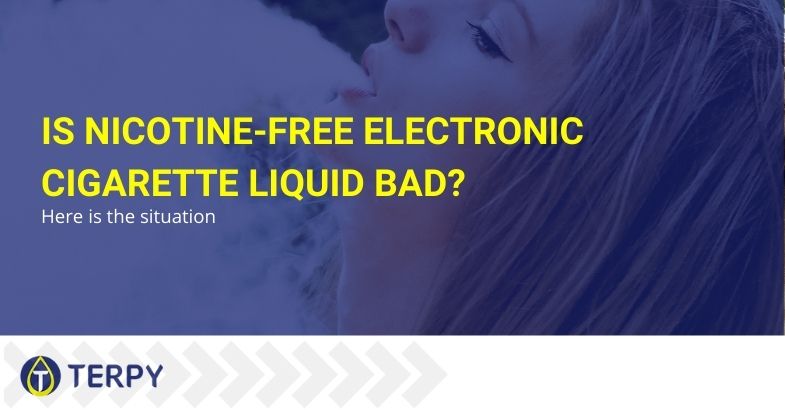Modified on: 29/05/2024
Is there any damage caused by nicotine-free electronic cigarette liquids?
Leaving aside the personal pleasure, usually the long-term goal of people who approach the world of e-cigarettes (e-cig) is to stop smoking. Unlike many other medical devices (patches, chewing gum etc.), the electronic cigarette with e liquid is designed precisely to resemble a classic cigarette, replacing it entirely.
In the smoker’s head, the mimicry and the perception of “combustion” will also be very similar to those experienced with a real cigarette. The electronic cigarette is nothing more than a device with the size of a marker pen that vaporizes e cig liquid inside, rather than burning tobacco and consuming tar.


E-cigs contain liquid nicotine in typical levels between 6-24mg, in a mixture consisting of demineralized water, propylene glycol, vegetable glycerin and other substances, including e liquid flavors. Some do not contain nicotine, but only a flavored vapor.
The popularity of E-Cigs increased significantly in 2006 in the West, although they were popular in china several years earlier
According to the Annual Report on Smoking prepared by the Istituto Superiore di Sanità, today about two million Italians make occasional and non-use of electronic cigarettes. In Italy, in recent years, e-cigarettes have had a significant increase in popularity, especially those without nicotine.
The nicotine free alternative seems to be the healthiest option. However it can be argued that there is insufficient evidence that the aspirated liquid does not cause damage due to the substances that make it up. Anyway the e cigarette flavours without nicotine hurts?- not sure what this means?
Read also: Electronic cigarette flavours: here is the top 5 of the most purchased on Terpy!
The introduction of vaping devices is too recent to be able to scientifically determine whether they cause health problems or not. However, there are some technical aspects that would suggest that the use of electronic cigarettes have less health implications.. Examples include:
- A typical cigarette contains about 4000 chemicals, 400 of which are toxic and at least 40 carcinogenic (E.g.. formaldehyde, arsenic, cadmium, tar, carbon monoxide, acetone, benzol, nicotine).
- The electronic cigarette without nicotine is composed of: vegetable glycerin (substance found in creams and syrups), propylene glycol (a food additive) and demineralized water. Regarding e liquid concentrates, it resembles food aromas such as popular desserts.
- In the electronic cigarette the liquid is brought to boiling point, thus vaporising it..
- In normal cigarettes, tobacco is combusted. In the smoke of a cigarette, which is obtained only at very high temperatures, carcinogenic components are released which are recognized as the main causes of diseases of the respiratory tract.
Danger of e cig liquids without liquid nicotine


After the initial boom of electronic cigarettes, many health concerns were raised. For example on the web there were titles such as “e cigarette liquid without nicotine hurts”. It suggested that the presumed presence of potentially harmful substances in the vapor of the e-cig, such as heavy metals.
Fortunately, there is a regulation that e-cigarettes and related manufacturers must respect and protect the health of consumers by monitoring the products that are placed on the market.
Despite the need for further studies, it is recognized that, compared to traditional tobacco consumption, electronic cigarettes can significantly reduce damage to the body As well as for those who live next to him (there are not similar effects to those of passive smoking) .
But it would be naive to think that e-cig is completely harmless. Even without nicotine it contains a substance called propylene glycol, the basic component of e liquids, which in the long term run can cause irritation to the nose, mouth and throat.
Read also: The importance of resistance in the electronic cigarette
Some final remarks
The electronic cigarette can be an effective measure for the reduction of damage to the respiratory tract, even if it is not entirely clear how much better it can be than the other methods used to overcome nicotine addiction.
Non-smokers, on the other hand, should avoid using them, with or without nicotine, since some substances present in the liquids of e-cigarettes could cause inflammation or infections of the respiratory tract.
For example, diacetyl (widely used in butter and also in some vaping liquids) is safe if ingested but is associated with bronchiolitis if inhaled for long periods and in high concentrations. These are rare events, which mainly concern predisposed subjects, but not negligible.
There is no doubt that smoking a traditional cigarette does more harm than that produced by an electronic cigarette and, if you want to quit smoking, opting for e-cig can prove to be a valid attempt. While using these devices for fashion and without having nicotine addiction, it can prove to be an unintelligent choice.
Obviously, there will always be conflicting opinions about it, and this will be so until there are no more data to deepen the studies on the effects of vaporized liquids.





